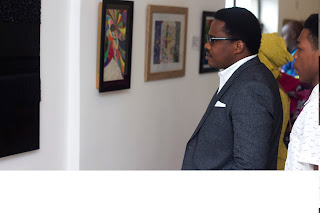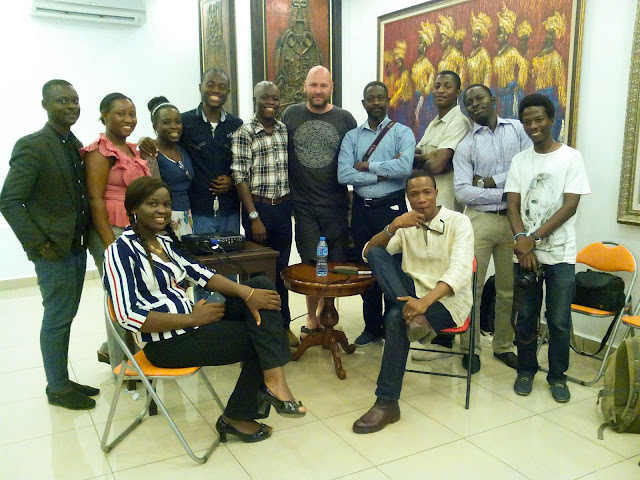 BONA Ezeudu is known for his work in metal and color media. He is a
member of the famous Aka Circle of Artistes and has established a
reputation with his works in local and international collections. With
his first solo exhibition in 1982, Ezeudu has over 14 solo exhibitions
and numerous group exhibitions including all AKA exhibitions, to his
credit.
BONA Ezeudu is known for his work in metal and color media. He is a
member of the famous Aka Circle of Artistes and has established a
reputation with his works in local and international collections. With
his first solo exhibition in 1982, Ezeudu has over 14 solo exhibitions
and numerous group exhibitions including all AKA exhibitions, to his
credit.Ezeudu is also known for his expressive canvas and board paintings and his utilitarian and ornamental wrought iron sculptures. With his expressive and stylistic explorations Ezeudu presents a travelling exhibition titled A Box of Delights, his recent experiment with conventional painting media is currently being exhibited at Thought Pyramid Arts Centre, Abuja. It will be hosted in Lagos later in the year.
It is the first solo exhibition of the artist in the FCT, and will provide an opportunity for the Abuja and Lagos audiences opportunity to see the latest studio work of Ezeudu using the conventional painting media.

Ezeudu has spent a greater part of his career advocating for the arts; he established a modern art gallery in Enugu – the Bona Gallery – and has space for emerging artists.
In March 2013, Ezeudu made a return to the arts arena after a long break with the exhibition The Old and New Testament. For many, the exhibition was a big relief as it settled the concern about the artist’s whereabouts in the art scene. Since then, Ezeudu has maintained his presence in the Nigerian art-space with two solos and some group exhibitions, the latest of which are the Anya Fulu Ugo Exhibition and dele jegede at 70 exhibition in Nsukka and Lagos respectively.
Ezeudu has also been engaged in his studio practice for over 30 years and has garnered local recognition within the artscape and widely beyond his Enugu state base. The artist began his career teaching at the Federal College of Education, Eha Amufu and then Institute of Management and Technology, Enugu, before leaving teaching to focus on full time studio practice. Also in his early years, Bona explored a great deal of wrought iron construction.
 In 1995 at the Lagos Hilton Hotel, Ikeja, Ezeudu presented the first
Box of Delights, a title from John Masefield’s 1935 novel, The Box of
Delights, which has also been adapted for several radio and television
series. Twenty years after, he brings another edition of delights.
In 1995 at the Lagos Hilton Hotel, Ikeja, Ezeudu presented the first
Box of Delights, a title from John Masefield’s 1935 novel, The Box of
Delights, which has also been adapted for several radio and television
series. Twenty years after, he brings another edition of delights.Through his oeuvre, Ezeudu has shown a creative manipulation of media and through a clever rendition of forms. From his Music Maker (1981), Ezeudu shows his near realistic presentation of forms in colourful brush strokes of a drummer hitting away at his wooden drum.
This shows an artist’s thorn between his attention to lively and exciting colours and subject matter. By the early 90s the artist’s practice began to reflect the privileging of colour over subject.. The works Nearby Village on a Market Day (1989), Welcoming her People (1990) and My People (1993) show the impressionist style.
The artist became completely absorbed in the expressive qualities of colour. Hence his Migrants (1991), Riverine Masquerade (1995)shows the artist’s high point as he just like a dancer absorbed in the drum beats enters a trance, oblivious of the audience as he explores blobs and abstract patches of colour.

In Age Grade Dance (2003), In Homage I (2004) and Trio (2005), Bona had gradually begun to drop his palette knife and big brush strokes in favour of smaller vibrant strokes.
As if the bigger brushes and palette knives could not accommodate his palette, he began to experiment with smaller slashes, and daps so as to enable him add more colours to his paintings as in First Outing (2002) and later manifested fully in his Fuel Subsidy I (2012) and Fuel Subsidy II (2012).
As if the color tubes could no longer satisfy him, Bona in his Money Through the Ages series, incorporated cowries, Manila coins and the old and new naira coins into his canvas.
This was perhaps in response to the Nigerian government’s failed attempt to reintroduce coins at that time.
In using his art to address socio-political and economic issues that negatively affect the society, he engaged themes that largely revolve around mundane living, nature and culture-based concepts especially those dealing with esoteric subjects like masks and masquerading.
---Published on The Guardian: http://www.ngrguardiannews.com/2015/09/bonas-box-of-delights-refreshes-aka-legacy/



























